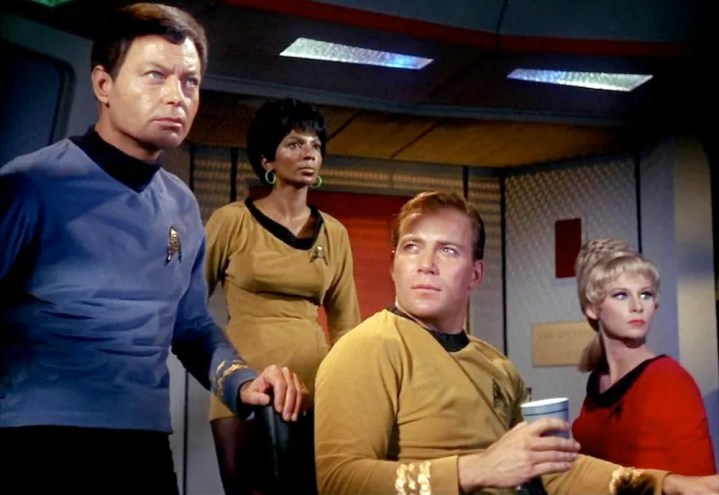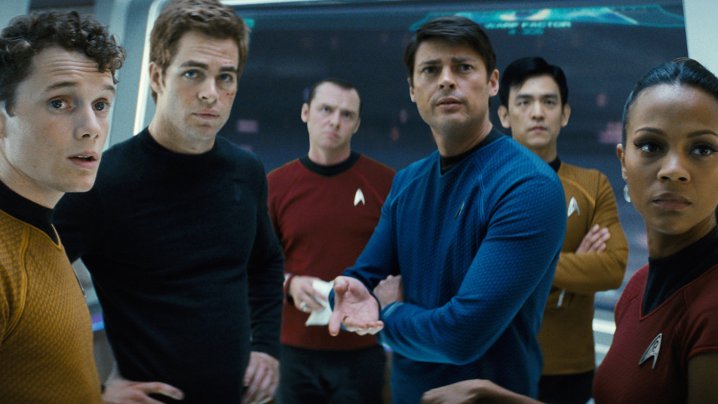Few science fiction franchises have made as enormous a cultural impact as Star Trek. Trek’s language and visual iconography, from “warp speed” to your phone’s built-in “live long and prosper” emoji, are ubiquitous even to people who have never seen the show. It’s the original organized “geek culture” fandom, and the birthplace of fan fiction and cosplay as we know it. The stigma of Trekkies as unwashed, socially awkward outcasts has dissipated as sci-fi and comics culture has gone mainstream, but Star Trek itself can still be intimidating to outsiders due to its massive scale and dense mythology of more than 800 episodes and films.
Though it’s possible to explore the Star Trek universe on your own, it is best navigated with the aid of a guide. And, if you don’t happen to have a Trekkie in your life to chart your course with you (which they absolutely love to do), we’re here to offer three options as to how to get started, depending on how you like to digest stories.
Course No. 1: The sampler platter

As of the time of this writing, there have been either 10 or 12 Star Trek television series (see? confusing already) and 13 Star Trek movies, spread across about 1,000 years and two different universes. Each individual series features its own spin on the basic premise of exploring strange new worlds and seeking out new civilizations, with their own subtly (or radically) different style and tone. They may not all be your cup of tea — and some are unquestionably stronger than others — but every one of them is someone’s favorite.
In order to get your bearings and decide where you might want to start, you may want to treat yourself to an assortment of episodes from across the franchise. To that end, we’ve selected one episode from each series that is not necessarily the best, but is the most representative of what it has to offer. If you enjoy the one we picked, you’ll probably find it worthwhile to watch through the series in question. For series with ongoing storylines, we’ve done our best to pick samples that are early enough in the run that they shouldn’t spoil any major plot developments. Each series is mostly self-contained, so if one of them excites you, you can feel free to jump right in from the beginning and come back to the sampler when you’re finished. Star Trek series often take some time to find their bearings (especially Star Trek: The Next Generation), but since you’ve been introduced via a strong example of the show’s potential, you’ll hopefully feel incentivized to grind through its weaker episodes. The shows that we do not recommend as any viewer’s first Star Trek — The Animated Series, Short Treks, and Picard — are excluded from this list.
- Star Trek: The Original Series – The Corbomite Maneuver (season 1, episode 11)
- Star Trek II: The Wrath of Khan (representing the film series)
- Star Trek: The Next Generation – Darmok (season 5, episode 2)
- Star Trek: Deep Space Nine – Duet (season 1, episode 19)
- Star Trek: Voyager – Night (season 5, episode 1)
- Star Trek: Enterprise – Broken Bow (season 1, episode 1)
- Star Trek: Discovery – Brother (season 2, episode 1)
- Star Trek: Lower Decks – Where Pleasant Fountains Lie (season 2, episode 7)
- Star Trek: Prodigy – Time Amok (season 1, episode 8)
- Star Trek: Strange New Worlds – The Serene Squall (season 1, episode 7)
Course No. 2: the TNG era

Though the original 1960s Star Trek is responsible for the franchise’s cult following and its survival as a cultural fixture during the long hiatus of the 1970s, the period from 1989 to 1999 was, without a doubt, Trek’s golden age. There were never more casual fans of Star Trek than in the 1990s, and the sheer volume of Star Trek being released was staggering. There are huge highlights in both classic and streaming-era Trek, but this is the period of time during which Star Trek was most consistently good, and its legacy continues into many of the modern installments of the franchise. This is the era of Picard, Data, Worf, Sisko, Janeway, and Seven of Nine, and it spawned much of Trek’s lingering iconography and cultural memes.
This golden age is widely considered to begin with the third season of Star Trek: The Next Generation, when new showrunner Michael Piller took the helm and built the writers’ room that would guide the franchise for the next decade. There are a few excellent episodes in those first two seasons, but starting with season 3 will spare you many of Star Trek’s worst hours. The success of TNG would lead to two direct spinoffs, Deep Space Nine and Voyager, whose overlapping runs allowed for a handful of characters and storylines to pass between them. Despite these interweaving threads, each series can be watched straight through without the need to bounce back-and-forth to understand what’s going on. (In the ’90s, nobody was expected to keep track of all that. Thanks, Marvel!)
- Star Trek: The Next Generation (beginning with season 3)
- The Next Generation film series
- Generations
- First Contact
- Insurrection
- Nemesis
- The Next Generation film series
- Star Trek: Deep Space Nine
- Star Trek: Voyager
Once you’re through with these shows, you can press on to their various follow-up series from the streaming era:
- Star Trek: Lower Decks, an animated sitcom set after the TNG era that lovingly and liberally lampoons its tropes
- Star Trek: Picard, a sequel to the TNG films and, to a lesser extent, Voyager
- Star Trek: Prodigy, an all-ages animated series that is a spiritual sequel to Voyager
Once you’ve exhausted this material, if you’re still itching for more Trek, there’s the entire classic era to dig into, which you are now well-equipped to tackle in whatever order you’d like.
Course No. 3: the new old school

In 2009, the hibernating Star Trek franchise kicked back into high gear with a new trilogy of big-budget motion pictures, beginning with the film simply called Star Trek. Based on The Original Series but set in its own continuity (which has since been named the Kelvinverse), these films repackage Star Trek’s classic characters like Kirk, Spock, and Uhura into the context of a modern blockbuster. The pace and tone have more in common with Star Wars than with any Trek that came before, but it’s a fun and exciting on-ramp to the franchise that happens to segue very easily into the first of the modern streaming series, Star Trek: Discovery.
While set in the Prime Universe (along with the rest of the core Trek canon), Discovery borrows its visual language and heightened emotional tone from the Kelvinverse films, making it a natural next step for fans of the modern trilogy. Discovery is also one of the earliest jumping-on points in the chronology of Trek, and its second season leads directly into the latest and most acclaimed series, Strange New Worlds, which in turn creates both a tonal and chronological bridge to The Original Series. From there, you’re off to the races, able to traverse the rest of the Star Trek Universe in what, for the most part, will be both production order and story order.
- The Kelvinverse Film Trilogy: Star Trek, Star Trek Into Darkness, Star Trek Beyond
- Star Trek: Discovery (seasons 1 and 2)
- Overlaps with Short Treks
- You can finish Discovery here, too, but it might be more fun to pick it up chronologically much, much later)
- Star Trek: Strange New Worlds
- Star Trek: The Original Series
- Star Trek: The Animated Series, which is basically just a low-budget TOS season 4
- Star Trek classic film series
- The Motion Picture
- The Wrath of Khan
- The Search for Spock
- The Voyage Home
- The Final Frontier
- The Undiscovered Country
- Star Trek: The Next Generation
- The Next Generation film series:
- Generations
- First Contact
- Insurrection
- Nemesis
- Star Trek: Deep Space Nine
- Star Trek: Voyager
- Star Trek: Enterprise (chronologically, this actually comes first, but you’re better off watching it here, in production order)
- Star Trek: Lower Decks
- Star Trek: Prodigy
- Star Trek: Picard
- Star Trek: Discovery (seasons 3-5)
There are, no doubt, a dozen other ways to get into Star Trek. You can search online and find Star Trek viewers’ guides that are as old as the World Wide Web itself, and they’ll all be at least a little different. Every series has its ardent defenders who insist that it’s the only one you need to watch, and every series has its haters who would see it struck from the canon altogether. What we offer are the tools to go boldly into that vast unknown and discover for yourself. We’ll see you out there.



